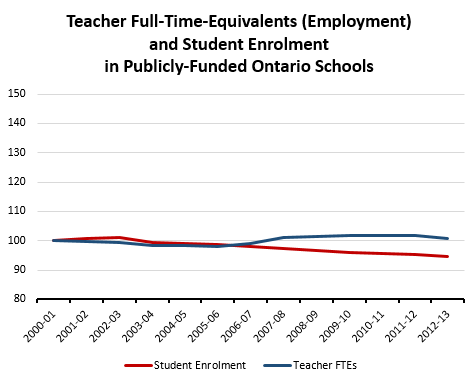It’s election time in Ontario and that means graphs and statistics, facts and factoids, some stale, some new come out of the woodwork. Take the tweet below as an example, one that riffs on the old theme of an exploding public sector encapsulated in Tim Hudak’s promise to cut 100,000 public service jobs:
Hudak promises to cut 100K public sector jobs (with education bearing the brunt). I put together this chart. Discuss pic.twitter.com/aNJjz5tiJ1
— Ben Rabidoux (@BenRabidoux) May 13, 2014
Let us even take the author’s word that he is non-partisan and found some seemingly interesting data; the focus is the chart, not him. There are two issues. The first is much simpler: the graph is a misportrayal. It uses data from a Statistics Canada sample-based survey to proxy for teacher employment and population data to proxy for student enrolment. While using proxies for missing data can be acceptable and justified, in this case, there is absolutely no reason for it. Both teacher employment data and enrolment data are exhaustively compiled by Ontario’s Ministry of Education. Here is the same graph with correct data:
(Note: FTEs are a much better measure of teacher employment as they specify the amount of teaching work being done, not the amount of people doing it. For example, a school could hire 10 teachers at 40 hours per week, or 20 part-time teachers at 20 hours per week. Both options represent the same amount of teaching, the same outlay for wages and 10 FTEs. What remains to be explained is the discrepancy between the two graphs; culprits include a rise of part-time contracts, a broader occupational net in the Statistics Canada data, sampling limitations and a host of other factors.)
The first, problematic, graph suggests an rapidly growing population of teachers, prime grist for the mill of Hudak’s axe. The second graph corrects this picture, popping the teacher bubble, showing the number of teachers as almost perfectly tracking the number of students. Statistics need not be hard – but it can be slippery!
The second issue – or, really, set of issues – however, inhabits the much more difficult realm of politics. Truth be told, the precise facts about numbers of teachers are not driving Hudak’s job cut promises. Jobs cuts in the public sector are ideologically tied to a long-running transformation of labour markets. To make them palatable, they are hitched to the Progressive Conservative party’s other promise of a very shaky million-job bonanza, but the exact shape of teaching employment is of less consequence than other factors.
In the shortest of terms, this current batch of PC politics in Ontario fits particularly well into a decades-long process to reduce the power of workers in relation to employers and reduce the power of the welfare state to redistribute economic gains from the private sector. An important aspect of this process is the increased “flexibility” of labour. The promise to rapidly downsize Ontario’s public service is but one more potential concrete step in the attempt to remake Ontario’s and Canada’s labour market.
The context of this election is an economy with less and less secure long-term employment, un- and underemployment that keeps young people in school longer and continuously-declining levels of unionization. Concretely, the Ontario College of Teachers reports that in 2012, over one-third of graduating teachers who looked for teaching work ended up unemployed in their first year post-graduation. Increasing rather than decreasing teaching positions could not only help young workers enter their field, create the potential for more secure forms of employment but also positively impact on education outcomes through reduced class sizes.
Another troubling aspect of the proposed dramatic job cuts in the public sector is their deeply gendered nature. The three job categories Hudak has said he will not touch are police officers, nurses and doctors. While nursing remains a predominantly female profession, fully 82% of all Ontario police officers are men as are 63% of Ontario physicians (2010 and 2014 data respectively). Teaching, one of the jobs that has been particularly singled out for cuts, remains largely women’s work; indeed, 71% of all FTEs in education are held by women. As has been shown repeatedly, while the pay gap between the public and the private sector is a myth, women and particularly lower-paid women earn more in the public sector and experience a narrower pay gap with men. Cutting large numbers of teaching jobs will reduce some of these gains.
Plans to dramatically cut public sector and teaching employment hit out at youth and women in particular, but affect all workers in the final calculation. They presage what shape any (far fewer than one million) newly-created jobs will take: precarious and insecure. In general, the greater degree of unionization in the public sector is closely tied to Tim Hudak’s plan to cut 100,000 public sector jobs, especially in the context of a platform ostensibly focused on job creation.
Reshaping the labour market to the detriment of workers is a tough sell and equally feeds off of fantasy predictions and statistical fantasies to generate support. Getting the data right is only one step, keeping the broader politics in sight is the real tool for reversing long-standing trends whether they will be shaped by Hudak or others.

One reply on “Hudak’s plans to cut teachers in statistics and politics”
It just goes to prove (or, rather, provide a single data point’s worth of evidence, which I recognize is far from proof, as you’ll no doubt point out) that if you look hard enough—and that often doesn’t require a lot of searching—you can find data to back up pretty well any assertion, bogus though that data may be. The sad part is, when it comes to moving minds of the masses, accuracy is much less important than plausibility and promotion.
Thanks for analyzing the problems of that tweeted graph for us.